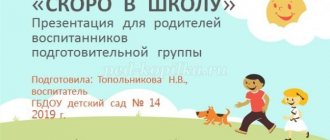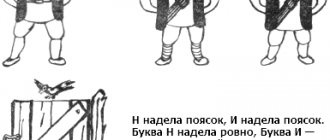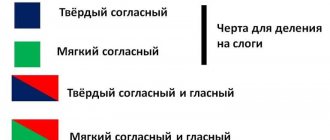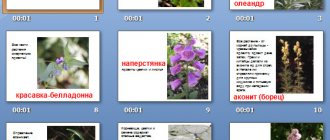Educational cards for “ABC” by V.G. Goretsky
Educational cards for the textbook “ABC” by V. G. Goretsky and others.
(UMK “School of Russia”)
Author:
Sokolova Elena Borisovna, primary school teacher
MCOU secondary school with UIOP named after V.I. Desyatkova Belaya Kholunitsa
Explanatory note
Card format:
double-sided cards - on one side there are blocks of words, on the reverse side - didactic tasks for them in text and/or symbolic form.
Recommended class to use:
1.
Recommended period of use:
alphabetic period of learning to read and write using the ABC. The first card is offered to children when 8 letters have been learned - 5 vowels and 3 consonants.
Relevance of the idea:
Children enter grade 1 with different levels of reading proficiency: some read syllables, there are children who already read quite fluently, but there are also children who know only individual letters of the alphabet. At the same time, a beginning reader can have relatively high technical reading skills (speed, reading whole words) with a parallel low level of reading comprehension. It is necessary for each student to provide conditions for the development of both the technical and semantic aspects of reading, as well as to create positive reading motivation in children.
At the first stage of mastering reading, systematic reading exercises are necessary, but repeated re-reading of words in the ABC, on the one hand, quickly becomes boring, and, consequently, creates negative reading motivation. On the other hand, after 2-3 repetitions of the same words, the child remembers them and no longer reads them, but simply reproduces the words from memory. Thus, the exercise becomes useless even for working on mechanical reading. At the same time, the textbook material often does not cover the zone of proximal development of children with a higher level of reading technique, and the words and texts of the ABC do not motivate them to read.
Novelty of the idea:
To overcome these circumstances, cards were developed with blocks of words for reading during the period of literacy training and didactic tasks for them. The words of the block are arranged in columns according to the degree of complexity of the type of syllable for reading: vowel + consonant, consonant + vowel, combination of consonants. The farther the column is located, the more complex the structure of the word. The cards contain proper names - full and abbreviated names of people, names of animals, geographical names; not only nouns are included, but also adjectives, verbs, numerals, adverbs; singular and plural forms of words, cognates are used. A variety of vocabulary encourages the child to carefully read each word and prevents reading by guesswork and mistakes in the endings of words.
A similar form of working with columns of words was proposed by G.G. Misarenko [1] and M.I. Omorokova [2]. But these authors suggest such work at the post-letter stage, when the child knows all the letters of the alphabet. The peculiarity of the cards I offer is that they are compiled taking into account the sequence of learning letters according to the “ABC” by V.G. Goretsky and others (UMK “School of Russia”). To ensure that reading is accessible to every student, the word blocks consist only of the letters currently studied.
Didactic tasks for blocks of words are aimed both at mastering reading techniques and at consolidating the learned grammatical concepts, propaedeutic acquaintance with grammatical and linguistic concepts, expanding and clarifying the vocabulary and horizons of students, developing associative thinking and coherent speech.
Type of work with cards:
Individual, paired, frontal work is possible in class and outside class under the guidance of an adult (teacher, parent) or independently.
Required knowledge and skills of a child to work with cards:
knowledge of the letters learned.
Expected results:
— formation and improvement of reading techniques (correctness, speed, expressiveness);
— developing the skill of viewing and selective reading;
— expansion of the passive dictionary;
— development of active vocabulary and coherent speech;
— formation and development of reading motivation;
- development of spelling vigilance.
Forms of working with the card:
The first card is given to students after learning 8 letters, each subsequent card is given to students after learning a new letter.
Tasks for working with word blocks are voiced by the teacher or read out by an adult (when working outside of class, at home) on the back of the card. Also, tasks are indicated in the form of symbols - this makes it possible for non-reading children to independently complete various tasks on the card. To develop goal-setting skills, you can give out a card with a blank back, where children can sketch the symbols themselves.
Tasks for the formation and development of reading technique:
Children read the words on the card in columns and rows in forward and reverse order (top to bottom and bottom to top, left to right and right to left). Taking into account the leading gaming activity at a given age, the task can be offered in the form of games: “Elevator”, “Descent/ascent from the mountain”, “Going along the highway”, “Sailing on a boat”, “Stream”. The gradual increase in the complexity of the structure of words in columns allows you to differentiate reading tasks, creating a situation of success for each child.
When working with the card, diction and expressiveness of reading are practiced - words are read smoothly (“sailing on a boat”), abruptly (“throwing the ball”); with constant or increasing/decreasing volume; with a certain mood (joyful, sad, affectionate, surprised). The ability to understand and manage your emotions is developing, which will further contribute to a positive attitude towards reading books and a better understanding of them.
Tasks for viewing and selective reading:
“Battleship” - search for words by their coordinates, for example: “second column, fourth word from the top.” A more complicated modification of this exercise: “Is it true that the penultimate word on the second line is “pine”? This task promotes the development of self- and mutual control; the correct answer increases the child’s self-esteem.
In the form of games “Detective”, “Sharp Eye”, “Snowball”, children are offered repeated viewing reading - a task of searching, reading, counting words with a certain letter. The exercise can be complicated and diversified by indicating the place of the letter in the word (beginning, end, middle). These same types of reading are used when selecting words into thematic groups: for example, “animals”, “people”, “winter”.
Selective reading allows, in parallel with mastering reading techniques, to consolidate the studied grammatical concepts:
Reading words starting/ending with a vowel/consonant.
Reading words with a specified number of syllables.
Reading words with emphasis on a specific syllable.
Reading words with more/less sounds than letters.
Reading words that cannot be transferred.
Correlating words with sound/syllable patterns suggested by the teacher.
When working with blocks of words on cards, there is a propaedeutic acquaintance with grammatical and linguistic concepts:
Reading proper names (Children quickly discover that these words are easy to find - they are written with a capital letter. Thus, there is a propaedeutic approach to writing proper names.)
Reading words in singular/plural.
Reading words that answer the question “Who?”/“What?”
Reading words - names of actions.
Reading words about which we can say “he”, “she”, “it”, “they” (practical acquaintance with personal pronouns, gender and number).
Search for related words; words of similar/opposite meaning (synonyms and antonyms).
Detection and explanation of the meaning of ambiguous words, words whose meaning changes with changes in stress (homographs).
The search field can vary from one column or line to the entire block. The amount suggested depends on the reading level of the majority of children in the class. The blocks include words that are often difficult for primary school students to spell. Repeated viewing of these words when working with a card allows you to form their image in the child’s visual memory and increases orographic vigilance.
Expansion of vocabulary and coherent speech:
Working with cards allows you to expand and clarify children's vocabulary. During the reading process, words are identified whose meaning is unclear to students or is misinterpreted by them. Each block intentionally includes words that are little known to primary schoolchildren: pomelo, Bremen, Chkalov, thistle, blacksmith. The presence of such words allows you to work on semantic reading and make reading “thoughtful.” Students are looking for ways to solve the problem - understanding words: getting an explanation from a teacher or parents, classmates, in dictionaries, the Internet. Children learn to use different ways to search for information and present it to classmates (talking about a word, showing a real object or its photograph, drawing). Unfamiliar words allow all children, both non-readers and readers, to improve their reading skills. Since, not knowing the meaning of the word, the child is forced to read the word, and not recognize it, reading by guess, which often fails novice readers.
Cards make it possible to work not only with individual words, but also to transition to coherent speech - sentences and text. Tasks for composing sentences and stories using words of the same column or line develop associative thinking and coherent speech.
The effect of novelty when receiving a new card with words, a variety of options for working with blocks of words, a situation of success in reading and searching for words, game situations - all this contributes to the formation of reading skills and allows you to create positive reading motivation in primary schoolchildren.
The use of these cards is useful both for children who have problems reading and for those who are successfully mastering the skill of reading.
The basis of the idea:
1. Misarenko G. G. Didactic material for the development of reading techniques in elementary school. - M.: Publishing house "ONICS 21st century", 2003.
2. Omorokova M.I., Rapoport I.A., Postolovsky I.Z. Overcoming difficulties: From the experience of teaching reading. – M.: Education, 1990. Blocks of words for DOC training cards / 65.5 Kb Assignments for DOC training cards / 218 Kb







